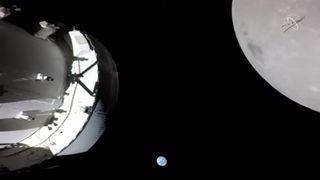
NASA unexpectedly lost contact with its moonbound Orion capsule early Wednesday morning (Nov. 23), for reasons that remain unclear.
The uncrewed Orion has been performing well since launching toward the moon last Wednesday (Nov. 16) on NASA's Artemis 1 mission. But this Wednesday (Nov. 23) brought a blip: Mission controllers lost communication with Orion at 1:09 a.m. EST (0609 GMT) while reconfiguring a link between the capsule and the Deep Space Network, the set of radio dishes that NASA uses to talk to its farflung spacecraft.
"The reconfiguration has been conducted successfully several times in the last few days, and the team is investigating the cause of the loss of signal," NASA officials wrote in a brief update on Wednesday.
"The team resolved the issue with a reconfiguration on the ground side," they added. "Engineers are examining data from the event to help determine what happened, and the command and data handling officer will be downlinking data recorded onboard Orion during the outage to include in that assessment."
Related: NASA's Artemis 1 moon mission: Live updates
More: 10 wild facts about the Artemis 1 moon mission
The communication outage lasted 47 minutes, and Orion came out of it in good shape; the spacecraft is healthy and suffered no apparent ill effects, NASA officials said.
Orion is gearing up for a crucial maneuver: It's scheduled to perform an engine burn on Friday (Nov. 25) that will insert the capsule into orbit around the moon. If all goes well, Orion will stay in that orbit for about a week, then head back toward Earth on Dec. 1.
Get the Space.com Newsletter
Breaking space news, the latest updates on rocket launches, skywatching events and more!
The capsule will arrive here with a parachute-aided splashdown in the Pacific Ocean off the California coast on Dec. 11.
Artemis 1 is a shakeout cruise for Orion and NASA's giant Space Launch System, the most powerful rocket ever to fly successfully. The duo are slated to fly astronauts for the first time in 2024 on Artemis 2, which will send a crewed Orion around the moon.
Artemis 3 will follow a year or so later, landing astronauts near the moon's south pole — the place where NASA aims to build a crewed outpost, one of the main goals of its Artemis program.
Mike Wall is the author of "Out There" (Grand Central Publishing, 2018; illustrated by Karl Tate), a book about the search for alien life. Follow him on Twitter @michaeldwall. Follow us on Twitter @Spacedotcom or Facebook.
Join our Space Forums to keep talking space on the latest missions, night sky and more! And if you have a news tip, correction or comment, let us know at: community@space.com.

Michael Wall is a Senior Space Writer with Space.com and joined the team in 2010. He primarily covers exoplanets, spaceflight and military space, but has been known to dabble in the space art beat. His book about the search for alien life, "Out There," was published on Nov. 13, 2018. Before becoming a science writer, Michael worked as a herpetologist and wildlife biologist. He has a Ph.D. in evolutionary biology from the University of Sydney, Australia, a bachelor's degree from the University of Arizona, and a graduate certificate in science writing from the University of California, Santa Cruz. To find out what his latest project is, you can follow Michael on Twitter.
-
Mark001 Is there any indication that this loss of signal could be due to jamming or sabotage from an un freindly nation like Russia or North Korea?Reply -
LabRat Has NASA 'Lost contact again', or is their web server (https://www.nasa.gov/specials/trackartemis/) just getting overloaded?Reply
This message was displayed at 08:03:03 (D:H:M). Mission Elapsed Time.
TRYING TO RECONNECT We temporarily lost our signal and are trying
to reconnect - hang tight. While we work on
it, please try refreshing the page, or check
nasa.gov for mission updates.
Most Popular


